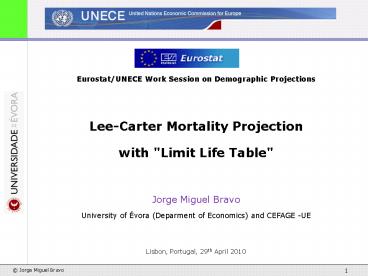Eurostat/UNECE Work Session on Demographic Projections - PowerPoint PPT Presentation
Title:
Eurostat/UNECE Work Session on Demographic Projections
Description:
Title: Mestrado em Economia Author: Jorge Bravo Last modified by: Wanders Created Date: 2/24/2003 6:46:04 PM Document presentation format: On-screen Show – PowerPoint PPT presentation
Number of Views:85
Avg rating:3.0/5.0
Title: Eurostat/UNECE Work Session on Demographic Projections
1
- Eurostat/UNECE Work Session on Demographic
Projections - Lee-Carter Mortality Projection
- with "Limit Life Table"
- Jorge Miguel Bravo
- University of Évora (Deparment of Economics) and
CEFAGE -UE - Lisbon, Portugal, 29th April 2010
2
Agenda
- Introduction and motivation
- Classical Lee-Carter mortality modelling
- Lee-Carter Model with "Limit Life Table
- Implementation issues
- Concluding remarks and further research
3
Mortality forecasting methods
- Mortality forecasting methods currently can be
classified into - 1. Explanatory methods
- Based on structural or causal epidemiological
models, analyze the relationship between
age-specific risk factors (e.g., smoking) and
mortality rates - 2. Expert-opinion based methods
- Involve the use of informed expectations about
the future, alternative low/high scenarios or a
targeting approach - 3. Extrapolative methods
- Assume that future mortality patterns can be
estimated by projecting into the future trends
observed in the recent to medium-term past (e.g.,
Lee-Carter, APC methods)
4
Extrapolative methods
- Why do we use extrapolative methods? Because...
- of the inherent complexity of the factors
affecting human mortality - of the current lack of understanding of the
intricate mechanisms governing the aging process - of the relative stability of the past demographic
trends - they offer a reliable basis for projection
- So whats the problem?
- ... using extrapolative methods is like driving
a car through the rear mirror ...!
5
Extrapolative methods limitations
- Since the methods rely on the assumption that
future mortality trends will continue into the
future as observed in the past, they may - generate biologically implausible scenarios
(e.g., null mortality rates for all ages) - produce implausible age patterns
- Crossover of consecutive mortality rates
- Crossover of male/female life expectancy
- produce increasing divergence in life expectancy
6
Classical AP Lee-Carter model
- Age-Period demographic model
- Identification constraints
- Fitting method OLS by Singular Value
Decomposition (SVD) - Forecasting Age effects (?x and ?x) are assumed
constant a time series ARIMA (p,d,q) model for
the time component (kt) - Problem Asymptotic behavior of the model
7
AP Lee-Carter model
8
AP LC Model with Limit Life Table
- Basic idea (Bravo, 2007)
- There is a target life table to which longevity
improvements over time (over a projection
horizon) converge - We explicitly admit that there are (at least in a
limited time horizon) natural limits to longevity
improvements - Rationale
- there is a decline in the physiological
parameters associated with ageing in humans ?
duration of life is limited? - stylized facts slowdown in life expectancy at
birth increases observed in many developed
countries
9
AP LC Model with Limit Life Table
- Hip. 1 the age-specific forces of mortality are
constant within each rectangle of the Lexis
diagram - Hip. 2 Let denote the
instantaneous death rate or probability of death
corresponding to this target life table - Hip. 3 AP LC model is formulated within a
Generalized Linear Model (GLM) framework with a
generalized error distribution - ? age- and period-specific numbers of deaths are
independent realizations from a Poisson
distribution with parameters
10
AP LC Model with Limit Life Table
- Age-Period demographic model
- with
- identification constraints
- GLM model of the response variable Dx,t with
logarithmic link and non-linear parameterized
predictor
11
AP LC Model with Limit Life Table
- Fitting method ML methods with theory-based
distributional assumptions instead of empirical
measures (i.e., OLS) - Parameter estimates are obtained by maximizing
the log-likelihood function - with
12
AP LC Model with Limit Life Table
- Because of the log-bilinear term ?xkt we cannot
use standard statistical packages that include
GLM Poisson regression - Solution Use an iterative algorithm for
estimating log-bilinear models developed by
Goodman (1979) based on a Newton-Raphson
algorithm ? Updating-scheme - Adjust parameter estimates to meet identification
constraints - Forecasting Age effects (?x and ?x) constant and
a time series ARIMA (p,d,q) model for the time
component (kt)
13
Implementation issues
- We need a limit/target life table as input ?
subjective/informed assumptions about the future
development of a set of important biological,
economic and social variables have to be made - Alternative approaches
- Use an epidemiological model to define the target
life table (TLT) - Consider the life table of a more advanced
population as TLT - Use the observed gaps between countries and
regions - combination of the lowest mortality rates
observed by sex-age groups - estimates of the lowest achievable cause-specific
death rates - Calibrate some mortality law to express different
scenarios on the main trends in human longevity
(e.g., rectangularization survival curve, life
expectancy trends, median, mode, entropy,
IQR,...)
14
Implementation issues
- Duchêne and Wunsch (1988) hypothetical limit life
table
15
Implementation issues
- 2nd Heligman-Pollard (1980) mortality law
16
Concluding remarks
- The asymptotic behaviour of the AP LC is
unsatisfactory - We argue that a combination of expert-opinion and
extrapolative methods can be used to forecast
mortality rates within the Lee-Carter framework ?
limit/target life table - The key implementation is the definition of the
target life table - Future research
- Experiment with alternative parameterizations of
the GLM demographic model (e.g., age-specific
rates of convergence) - Consider cohort-specific targets
- Consider gender-specific targets
17
- THANK YOU
- JORGE MIGUEL BRAVO
- (jbravo_at_uevora.pt)
Eurostat/UNECE Work Session on Demographic
Projections































